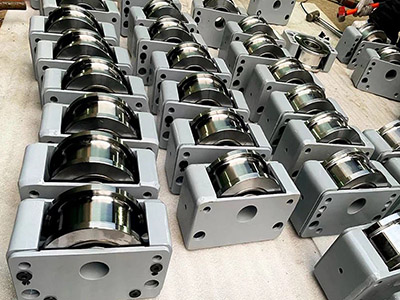The Demag Modular Wheel Block serves as a critical component in warehouse management systems, especially within automated material handling applications and heavy-duty equipment like cranes, conveyors, and trolleys. Its core function is to bear the weight of moving machinery while enabling smooth and efficient goods transport.
The motorised wheel block system ensures operational stability and effective load distribution, significantly influencing both performance and service life of the equipment. Proper functioning of the Rail Guided Vehicle (RGV) traveling wheel block reduces friction, improves mobility, and minimizes wear on both the wheels and the track—thereby enhancing overall operational efficiency.
Furthermore, the wheel block contributes substantially to safety by facilitating controlled movement and stable motion, which helps prevent accidents and protect cargo from damage.
Installation Method
The installation of a wheel block in a warehouse environment requires precision to ensure optimal performance. The process typically involves the following steps:
Preparation of the Track: Prior to Industrial Wheel Block installation, the track or rail system must be thoroughly cleaned and leveled. Any obstructions or debris on the track can interfere with the smooth movement of the wheel block, leading to potential damage or inefficiency.
Alignment of the Wheel Block: The Demag drive wheels must be aligned with the track to ensure proper tracking and prevent skewing or off-center movement. For this purpose, advanced measuring tools like laser alignment devices are often used. Accurate alignment prevents uneven wear and tear on both the wheel block and the track, extending their lifespan.
Securing the Wheel Block: Once aligned, Demag Wheel Range is typically bolted or welded onto the structure of the equipment or supporting framework. For adjustable wheel blocks, bolts may be used to allow for fine-tuning of height and angle, ensuring smooth operation across different load conditions.
Testing and Adjustment: After installation, the system is tested by running the equipment through a series of movements. Adjustments to the tension or position of the wheel block may be made as necessary to ensure that it moves smoothly along the track, handling the anticipated load capacity.

Conclusion
The drive wheel block system is an essential component in warehouse operations, enabling smooth, efficient, and safe movement of equipment and goods. Proper installation, precise alignment, and robust structural features—such as high load capacity and reliable bearing mechanisms—are critical to maintaining operational efficiency and extending equipment service life. Widely used in conveyor systems, automated storage systems, and overhead cranes, wheel blocks help reduce friction, minimize wear, and support heavy loads, thereby enhancing overall productivity and safety in warehouse environments.
Shiyang specializes in the design and manufacturing of wheel blocks. We offer custom solutions tailored to your specific requirements, including various installation types such as top, bottom, and side mounting, as well as configurations with or without tracks. Our products are available in a range of materials including polyurethane, stainless steel, PEEK, and other engineering polymers. You may provide direct drawings or share your operational needs—our team will assist with the design and engineering. We look forward to collaborating with you.
For detailed technical specifications or application support, contact us.